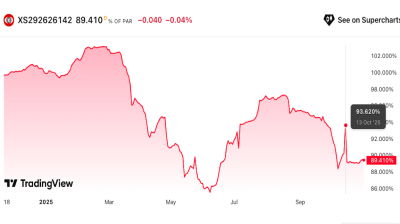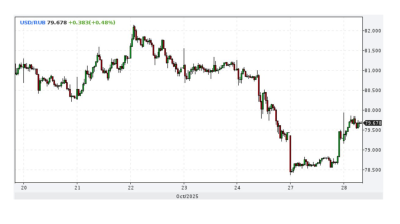Rising wages in Central and Eastern Europe (CEE) have helped lead to a 14% loss of overall competitiveness relative to the region’s main trading partners since 2020, according to a report by economic consultancy Capital Economics. It predicts that a prolonged period of high labour cost growth due to structural supply constraints in labour markets will cause a further erosion of competitiveness.
The growth in CEE labour costs has been among the highest in the world in the past few years, propelled by rising inflation and tight labour markets. Labour costs per worker in Poland, Czechia and Hungary have risen by 12% y/y on average since 2022, significantly above the 2000-19 average of 5% y/y.
Unit labour costs (ULCs) have surged by 28% since 2020 – something not seen since the early 2000s – reflecting a combination of rapid labour cost growth and exceptionally weak productivity. During 2000-19, ULC growth in CEE averaged only 2-3% per year. When rises in unit labour costs in competitors and currency depreciations are taken into account, CEE has become 14% less competitive since the start of 2020.
The rise in ULCs is largest in Hungary, Romania and Bulgaria (30%) and Poland (25%) and smallest in Czechia and Slovakia (10%). However, because the Czech koruna has actually appreciated by 10% against the euro since 2015, the loss of cost competitiveness in Czechia has been much bigger. The Hungarian forint has depreciated by 20% against the euro over the same period.
In its baseline scenario Capital Economics expects average labour cost growth in CEE to slow from 11.0% y/y in 2023 towards 5.5% in 2026 and remain there over the rest of the decade. This would still be stronger than that recorded over 2010-19 (4.0% y/y).
This trend reflects continuing structural supply constraints in the region’s labour markets because of falls in working age populations, limited increases in labour participation among 65s+ and ongoing emigration.
Capital Economics also predicts that productivity in CEE – which is likely to have contracted by 1.0% in 2023 – will return in the second half of this decade to the average growth rates of 2.0-3.0% y/y over 2010-19. This reflects expected relatively healthy rates of FDI, continued inflow of EU funds and further transfers of skills and technology.

Putting labour costs and productivity together, the consultancy projects CEE unit labour cost growth of 5.0% y/y in 2024, 3.5% in 2025 and 3.3% from 2026. This would be higher than that over 2010-19 of 2.0% per year.
This would mean that unit labour costs in CEE relative to Germany could rise by a further 14% between now and the end of this decade, taking the cumulative increase over 2020-29 to 32%.
Such a rise in ULCs would hit exports and make the economies less attractive as a destination for foreign investment.
Hungary, Bulgaria and Romania are at risk of experiencing the biggest rise in ULCs relative to Germany in the coming years, the report says. It forecasts ULC growth in those countries to remain at 4.0-4.5% y/y over the rest of this decade.
Nevertheless labour costs in CEE look set to remain much lower than those in Germany, meaning that labour cost growth is unlikely to be large enough on its own to completely undermine CEE’s cost advantages.
Average labour costs per hour worked in CEE were €11 in 2022 compared to €37 in Germany, a ratio of about 30%. Value added per worker was 45% of that in Germany, meaning that each €1 spent on labour cost per person in CEE still produced on average 35% more value added than in Germany.
What’s more, CEE economies exhibit large cost advantages in other areas too, including land and property values compared to the rest of Europe.
There’s also scope for CEE economies to improve the technological intensity of exports and move up the value chain. The share of high-tech manufactured goods in total goods exports in CEE (12%) is not much higher than in Brazil, India and South Africa (around 10%).
Capital Economics therefore forecasts that GDP growth in CEE is likely to average 2.5-3.0% over the rest of this decade.
The main impact of high labour cost growth is likely to be felt through a prolonged period of high inflation (particularly in Hungary, Romania and Bulgaria).
A material loss of cost competitiveness because of high labour cost growth and inflation differentials is also likely to result in weaker nominal exchange rates. It predicts CEE currencies to depreciate by 5-10% on average against the euro by 2030.
The appreciation of the Czech koruna – 35% since 2015 – has already led to a tipping point and the start of depreciation. Capital Economics predicts Hungary, Bulgaria and Romania also run the risk of approaching this tipping point in the coming years. Depreciations of 5-10% by the end of this decade will offset around a third of the rise in relative ULCs with Germany that the consultancy predicts.
Data

Russia’s manufacturing PMI falls to its lowest level since May 2022 in October
Russia’s manufacturing sector saw a deeper contraction in October, with output, new orders, and business confidence all weakening, according to the latest Purchasing Managers’ Index (PMI) data from S&P Global, published on November 1.

Czech growth accelerates as domestic demand-side pressure builds
The Czech economy delivered an unexpected acceleration in the third quarter, marking a clear shift from its earlier position as a regional underperformer to one of Central and Eastern Europe’s fastest-growing economies.

Eurobonds of Istanbul-listed Zorlu units offer attractive yields amid rating downgrades and no default expectation
Debut paper currently offering 14-15% yield.

Ruble strengthens as sanctioned oil companies repatriate cash
The Russian ruble strengthened after the Trump administration imposed oil sanctions on Russia’s leading oil companies, extending a rally that began after the Biden administration imposed oil sanctions on Russia in January.




